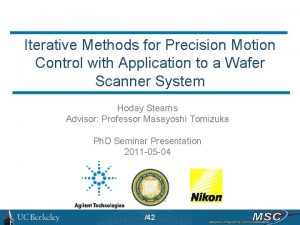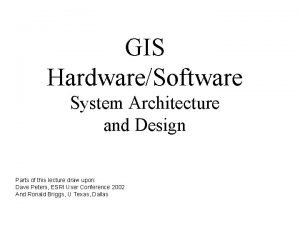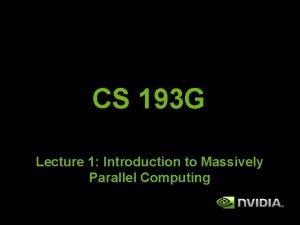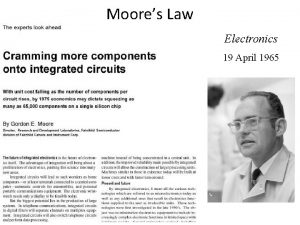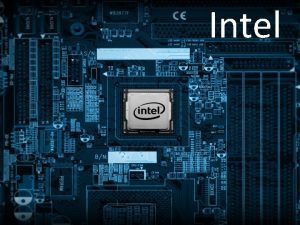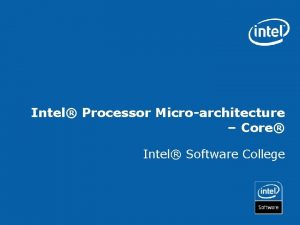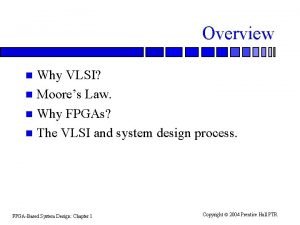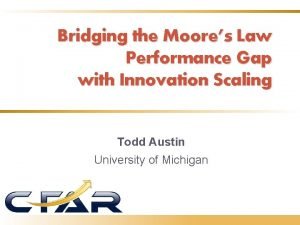Moores Law Gordon Moore cofounder of Intel n
































- Slides: 32

Moore’s Law Gordon Moore: co-founder of Intel. n Predicted that number of transistors per chip would grow exponentially (double every 18 months). n Exponential improvement in technology is a natural trend: steam engines, dynamos, automobiles. n FPGA-Based System Design: Chapter 1 Copyright 2004 Prentice Hall PTR

Moore’s Law plot FPGA-Based System Design: Chapter 1 Copyright 2004 Prentice Hall PTR

The cost of fabrication Current cost: $2 -3 billion. n Typical fab line occupies about 1 city block, employs a few hundred people. n New fabrication processes require 6 -8 month turnaround. n Most profitable period is first 18 months-2 years. n FPGA-Based System Design: Chapter 1 Copyright 2004 Prentice Hall PTR

Cost factors in ICs n For large-volume ICs: – packaging is largest cost; – testing is second-largest cost. n For low-volume ICs, design costs may swamp all manufacturing costs. – $10 million-$20 million. FPGA-Based System Design: Chapter 1 Copyright 2004 Prentice Hall PTR

Mask cost vs. line width FPGA-Based System Design: Chapter 1 Copyright 2004 Prentice Hall PTR

Field-programmable gate arrays n FPGAs are programmable logic devices: – Logic elements + interconnect. – Provide multi-level logic. LE LE LE FPGA-Based System Design: Chapter 1 LE Interconnect network LE LE Copyright 2004 Prentice Hall PTR

FPGAs and VLSI n FPGAs are standard parts: – Pre-manufactured. – Don’t worry (much) about physical design. n Custom silicon: – Tailored to your application. – Generally lower power consumption. FPGA-Based System Design: Chapter 1 Copyright 2004 Prentice Hall PTR

Standard parts vs. custom n Do you build your system with an FPGA or with custom silicon? – FPGAs have shorter design cycle. – FPGAs have no manufacturing delay. – FPGAs reduce inventory. – FPGAs are slower, larger, more power-hungry. FPGA-Based System Design: Chapter 1 Copyright 2004 Prentice Hall PTR

Challenges in system design Multiple levels of abstraction: logic to CPUs. n Multiple and conflicting constraints: low cost and high performance are often at odds. n Short design time: Late products are often irrelevant. n FPGA-Based System Design: Chapter 1 Copyright 2004 Prentice Hall PTR

The system design process May be part of larger product design. n Major levels of abstraction: n – specification; – architecture; – logic design; – circuit design; – layout. FPGA-Based System Design: Chapter 1 FPGA-based system design Copyright 2004 Prentice Hall PTR

Elements of an FPGA fabric Logic. n Interconnect. n I/O pins. n IOB LE … LE interconnect LE LE LE … LE FPGA-Based System Design: Chapter 1 IOB LE LE Copyright 2004 Prentice Hall PTR

Terminology Configuration: bits that determine logic function + interconnect. n CLB: combinational logic block = logic element (LE). n LUT: Lookup table = SRAM used for truth table. n I/O block (IOB): I/O pin + associated logic and electronics. n FPGA-Based System Design: Chapter 1 Copyright 2004 Prentice Hall PTR

Logic element n Programmable: – Input connections. – Internal function. n Coarser-grained than logic gates. – Typically 4 inputs. Generally includes register. n May provide specialized logic. n – Adder carry chain. FPGA-Based System Design: Chapter 1 Copyright 2004 Prentice Hall PTR

Example logic element n a b Lookup table: a b 0 0010 memory 1001 FPGA-Based System Design: Chapter 1 out 0 1 1 0 0 1 0 1 Copyright 2004 Prentice Hall PTR

Logic synthesis How do we break the function into logic elements? n How do we implement an operation within a logic element? n FPGA-Based System Design: Chapter 1 Copyright 2004 Prentice Hall PTR

Placement n Where do we put each piece of logic in the array of logic elements? FPGA-Based System Design: Chapter 1 LE LE LE … LE LE Copyright 2004 Prentice Hall PTR

Programmable wiring n Organized into channels. – Many wires per channel. Connections between wires made at programmable interconnection points. n Must choose: n – Channels from source to destination. – Wires within the channels. FPGA-Based System Design: Chapter 1 Copyright 2004 Prentice Hall PTR

Programmable interconnection point D FPGA-Based System Design: Chapter 1 Q Copyright 2004 Prentice Hall PTR

Programmable wiring paths FPGA-Based System Design: Chapter 1 Copyright 2004 Prentice Hall PTR

Choosing a path LE LE FPGA-Based System Design: Chapter 1 Copyright 2004 Prentice Hall PTR

Routing problems n Global routing: – Which combination of channels? n Local routing: – Which wire in each channel? n Routing metrics: – Net length. – Delay. FPGA-Based System Design: Chapter 1 Copyright 2004 Prentice Hall PTR

Segmented wiring Length 1 Length 2 FPGA-Based System Design: Chapter 1 Copyright 2004 Prentice Hall PTR

Offset segments FPGA-Based System Design: Chapter 1 Copyright 2004 Prentice Hall PTR

I/O Fundamental selection: input, output, threestate? n Additional features: n – Register. – Voltage levels. – Slew rate. FPGA-Based System Design: Chapter 1 Copyright 2004 Prentice Hall PTR

Programming technologies n SRAM. – Can be programmed many times. – Must be programmed at power-up. n Antifuse. – Programmed once. n Flash. – Similar to SRAM but using flash memory. FPGA-Based System Design: Chapter 1 Copyright 2004 Prentice Hall PTR

Configuration n Must set control bits for: – LE. – Interconnect. – I/O blocks. n Usually configured off-line. – Separate burn-in step (antifuse). – At power-up (SRAM). FPGA-Based System Design: Chapter 1 Copyright 2004 Prentice Hall PTR

Configuration vs. programming n FPGA configuration: – Bits stay at the device they program. – A configuration bit controls a switch or a logic bit. FPGA-Based System Design: Chapter 1 n CPU programming: – Instructions are fetched from a memory. – Instructions select complex operations. add r 1, r 2 add. IR r 1, r 2 memory CPU Copyright 2004 Prentice Hall PTR

Reconfiguration n Some FPGAs are designed for fast configuration. – A few clock cycles, not thousands of clock cycles. n Allows hardware to be changed on-the-fly. FPGA-Based System Design: Chapter 1 Copyright 2004 Prentice Hall PTR

FPGA fabric architecture questions n Given limited area budget: – How many logic elements? – How much interconnect? – How many I/O blocks? FPGA-Based System Design: Chapter 1 Copyright 2004 Prentice Hall PTR

Logic element questions How many inputs? n How many functions? n – All functions of n inputs or eliminate some combinations? – What inputs go to what pieces of the function? n Any specialized logic? – Adder, etc. n What register features? FPGA-Based System Design: Chapter 1 Copyright 2004 Prentice Hall PTR

Interconnect questions How many wires in each channel? n Uniform distribution of wiring? n How should wires be segmented? n How rich is interconnect between channels? n How long is the average wire? n How much buffering do we add to wires? n FPGA-Based System Design: Chapter 1 Copyright 2004 Prentice Hall PTR

I/O block questions n How many pins? – Maximum number of pins determined by package type. Are pins programmed individually or in groups? n Can all pins perform all functions? n How many logic families do we support? n FPGA-Based System Design: Chapter 1 Copyright 2004 Prentice Hall PTR
 Pictures of eniac
Pictures of eniac Intel moore's law
Intel moore's law Moores law graph
Moores law graph Biu 8086
Biu 8086 Darroch moores
Darroch moores Moores head
Moores head Madison moore nude
Madison moore nude Moores ssm
Moores ssm Alex moores
Alex moores Andrew moores
Andrew moores Eldridge moores cause of death
Eldridge moores cause of death Larry page traits
Larry page traits Former xamarin cofounder icaza microsoft
Former xamarin cofounder icaza microsoft Cofounder brain startup company
Cofounder brain startup company Interpretations of more’s law assert that
Interpretations of more’s law assert that What is moore's law ?
What is moore's law ? Moore's law wiki
Moore's law wiki Moore's law
Moore's law Moore law wall streetjournal
Moore law wall streetjournal Moore's law
Moore's law Newton's first law and second law and third law
Newton's first law and second law and third law Si unit of newton's first law
Si unit of newton's first law V=k/p
V=k/p Constant in avogadro's law
Constant in avogadro's law Mitch gordon law
Mitch gordon law The other wes moore project
The other wes moore project Dr. mason moore
Dr. mason moore Ge moore intuitionism
Ge moore intuitionism Horspool algorithm
Horspool algorithm Emma moore bolton study
Emma moore bolton study David moore superintendent
David moore superintendent Andrew moore's basic probability tutorial
Andrew moore's basic probability tutorial Justin moore facebook
Justin moore facebook

